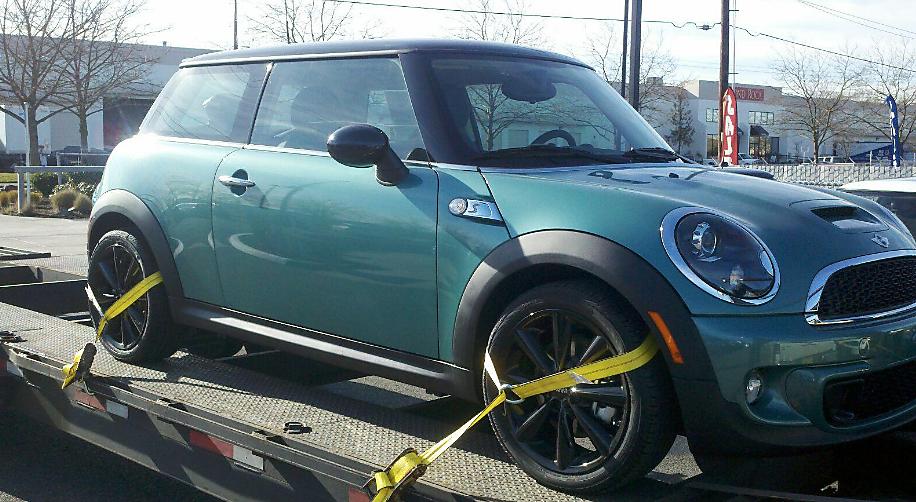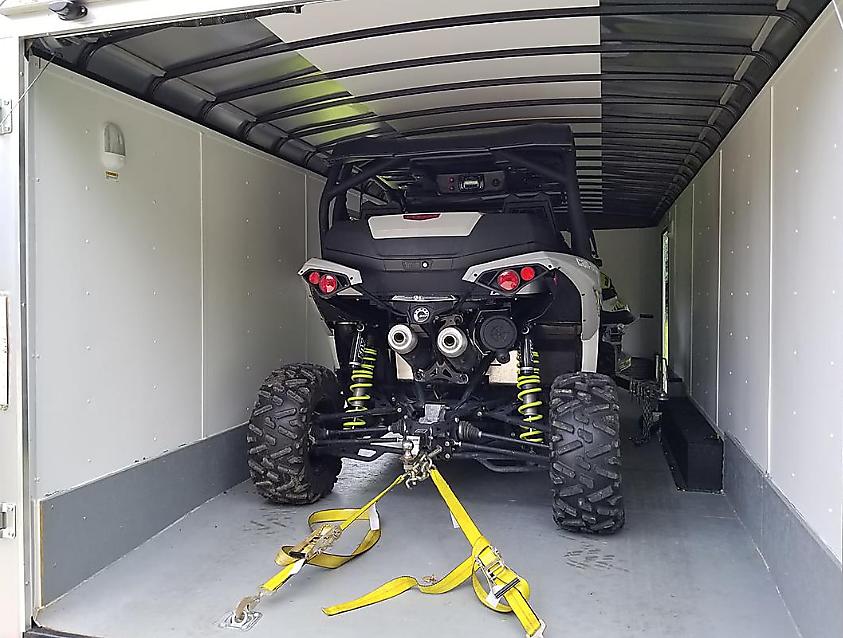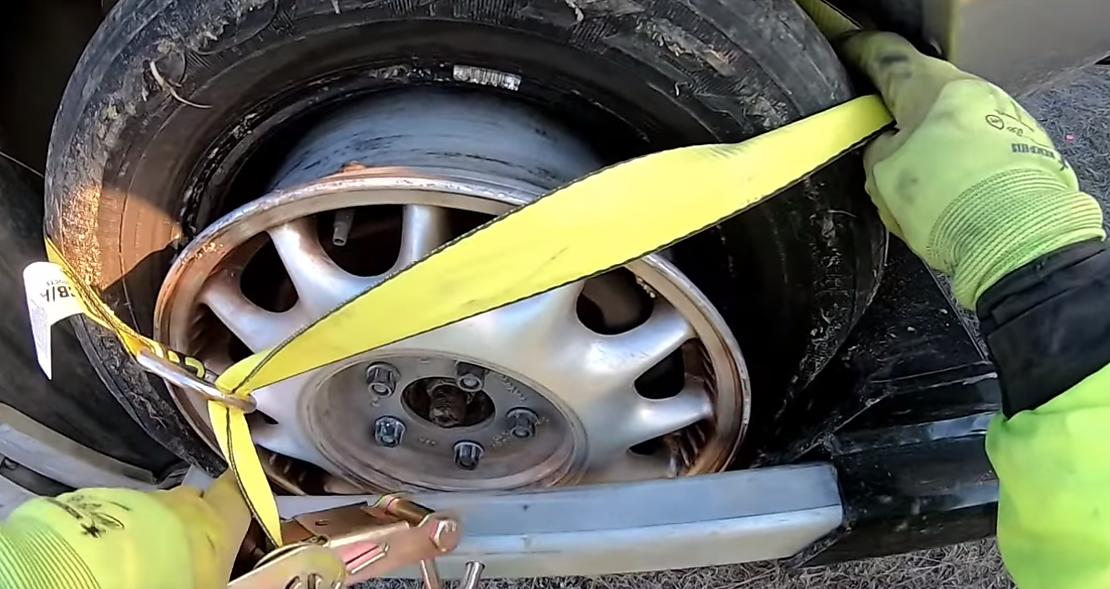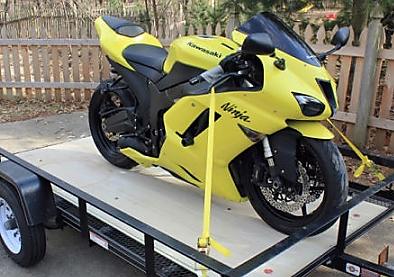Updated on 09/13/22
Today we will be going over some of the most frequently asked questions about car tie-down straps from ratchet strap experts.
One of the most common questions we tend to get at Ratchet Straps USA is how do I secure my vehicle to my trailer without the risk of any damage occurring to the vehicle, trailer, or other motorists? The answer is simple.
You will want to start by finding the strap that fits the weight of your vehicle best. You will want to find the gross weight of your vehicle in order to be able to find the working load limit (WLL) or in other words the amount of weight that is safely rated for your car tie-down straps of preference.
No matter the combination of car tie downs you end up using to secure your vehicle to a trailer or flatbed the rules of safety is the number priority remains the same. Here are some of the tips from the veterans of car tie-downs on trailers.

Car Tie Down Securement tips from the Pros
• Securing from Four Different Securement Points – Make sure to secure your vehicle from four different securement points using at least four tie-downs that are adjustable in order to balance the weight of your vehicle from weight shifts. Weight shifts can occur from a sudden lane change, sudden hard braking, or taking a corner a little too quickly. It is always okay to secure your vehicle with more than four car ties if needed or if you feel unsafe only use four. However, you should never use less than four tie-down straps when you are securing heavy cargo.
• Inspecting Your Tie Down Straps – Remember to always inspect your car tie-downs for damage around the edges of the tie-down webbing for cuts, mold, and mildew on the tie-down webbing, any defects in the metal hardware, or any burn marks. These defects can greatly damage your car tie-down straps and risk your vehicle of becoming damaged if they are used. If you find any of these defects on your vehicle’s straps please replace these straps immediately as they are unsafe to use.

• Retighten your Tie Down Straps Often – One of the tips from any car tie-down expert would be to always retighten your tie-downs after several miles of transporting your vehicle. Polyester Tie Down webbing stretches around 3 percent of the total length of the tie downs webbing on your straps. This is greatly reduced from other types of tie-down material such as nylon, but should always be retightened after a few miles to make sure the strength is able to keep your vehicle safely secured at all times. A great rule of thumb is to remember to check your tie-down straps after around 45-50 miles for the remainder of your trip.
• Keep the vehicle in park once loaded – Vehicles are not required to be in gear or to keep the transmission in park when being transported down the road, but it is an extra layer of safety due to the chance of moving being reduced.
• Determine if you need 4-point or 8-point vehicle securement – The two most common ways of vehicle securement are 4 points and 8-point securement. This is done through the use of either 4 ratchets or 8 ratchet straps typically two straps in the front and two in the back for a four-point securement. If you plan on doing an eight-point secure you will want to do four straps in the front and four ratchet straps in the back.
• Protect the rims of your vehicle when possible – Consider using two rags per tie or wool sleeve protectors in order to protect your vehicles or customers’ vehicles’ rims during securement. There is nothing worse than getting to your destination to notice scratches are placed around the rims of your wheels. Make sure to always consider doing this step no matter if the vehicle is a thousand dollars or a hundred thousand dollars the vehicle is important to someone and can greatly improve your chances of being a repeat customer.

How to Tighten Car Tie Down Straps Instructions
Make sure to avoid having straps make contact with wires and brake lines as they can become damaged during transit.
1. From the bottom side, thread the end of the webbing through the slot in the center spool of the Ratchet.
2. Then pull the webbing end back in the same direction that it just came from and pull to remove the excess slack.
3. Increase the tension of the strap by moving the ratchet handle up and down until it reaches the desired tension. The straps should be tight but not too tight because you do not want to damage your vehicle.
How to Loosen Car Tie Down Straps Instructions
1. To Release your Car Tie Downs, pull and hold the tab which is located near the handle to override the ratcheting function.
2. Continue to hold the tab and open the Ratchet until it is lying completely flat.
3. Pull the non-fixed end of the webbing through the spool as far as you need to in order to unhook the strap from your vehicle.
4. Pull the tab once again to close the Ratchet so it will be ready for your next tie-down project.
For a more in-depth look at vehicle securement and hauling, check out our other blog post, The 6 Best Ways to Safely Transport Vehicles.
The Different Types of Car Tie Down Straps
Axle Straps – Axle Straps are used to secure vehicles by the axle of the vehicle on trailers or flatbeds. Axles straps help to create a securement point using tools such as E Track Rails to prevent your vehicle from moving or becoming unsecured causing damage to your vehicle or trailer. Axle Straps are protected by Cordura Sleeves that are used to protect the webbing on the axle straps from sharp edges. Reducing sharp edges on tie-down straps can greatly increase the lifespan of the product by preventing friction burns or tears in the webbing from cuts. Axle straps are designed to connect with snap hooks in order to be tightened with ratchets providing a securement that is way tighter than simply hand strength.
Side Mount Wheel Nets – Side mount wheel nets work by going around the outside of the tire on the vehicles that are being secured to create a great securement point from four or six different points depending on the number of wheels that are being secured on the vehicle. Side mount wheel nets come with ratchets that are used for tightening the wheel nets into place creating a secure method to transport your vehicle safely. Wheel nets are extremely adjustable to fit just about any size of wheel on the car you are transporting.
Lasso Straps – Lasso straps is by far one of the more commonly used car trailer straps that are used mostly due to the easiness and due to how quickly you can secure a vehicle in just a few minutes. These straps are designed specifically for vehicle hauling purposes to make them more convenient and safer.
Over-The-Wheel Tie Downs – Wheel Tie Downs is one of the most commonly used types of car tie-down straps and are designed from tie downs that are made to be adjustable for your vehicles securement. These are very similar to traditional ratchet straps, but the number one difference is they are made with hardware options such as chain and hook, twisted snap hooks, and RTJ Hooks in order to secure vehicles from the perfect securement spots.

Shop our Car Tie Down Straps and Bundles

The Differences Between Car Tie Downs and Chains
The two main ways of securing a vehicle to a trailer are with the use of ratchet straps or with chains.
Chains for vehicle securement – Chains are considered to be stronger than straps. They are made from high-strength steel that does not stretch or rip. Many professionals in the industry use chains for these reasons but there are some downsides to chains that should be considered. Because chains are so rigid, if they are improperly secured they can cause damage to the frame of the vehicle. Frame damage on a car is very serious and in extreme cases can cause the car to be salvaged. Chains also require you to hook directly to the frame of the vehicle. The rigidity of the steel chains can cause the hooks to pull away at parts of the frame. And if the wrong hooks are used they could fall out and cause you to lose your load altogether!
Tie Down straps for vehicle securement – Car Tie Downs are made from polyester webbing and are designed specifically to cause no damage to the vehicle while hauling. The soft webbing allows the straps to slide over the wheels or around the axles of the vehicle for securement. The only downfall of straps is stretchiness. Polyester straps can stretch up to 3% during use. That number may seem low but it can make all the difference. That is why it is important to check your straps each time you make a stop.
Straps and chains are both capable of hauling vehicles. Each one has pros and cons and there is no general consensus on which one is better. The choice depends on the type of vehicle being secured, the state laws wherever you are hauling, and personal preference. As long as you do not exceed the Working Load Limit, you should be good to go.

Frequently Asked Vehicle Securement Questions
How Much Should I Expect My Car Tie Downs to Stretch?
Answer – On average polyester tie-down webbing blends will stretch 3% of the total length of tie-down webbing when secured. This is why it is always a great idea to make sure that you are rechecking your tie-downs after several miles of securing to retighten and after every 40-45 minutes after. This allows for a create chance to inspect if your tie-down straps are securing properly the vehicle properly, as well as checking for any sharp edge damage, broken straps, or burn marks on your car tie-downs. Although damage will not always occur, it’s better to know ahead of time if something is breaking when securing a vehicle.
How can you inspect your Car Tie Downs for Damage?
Answer – The best way to inspect your car tie-downs is before and after every use. The main thing you will want to look for is any webbing that has become frayed, thinned out webbing, burn marks, tears, mold, and mildew. If your car tie-down straps have any of these issues on the webbing you will want to replace the strap before the next use as they are unsafe to use and are at risk of failing.
How can you prevent Car Tie Downs from Breaking?
Answer – The number one way to play a part in making your car tie-down straps last is by storing them properly. Throwing your straps into a tangled pile in the back of your pickup truck bed is not the ideal way to secure them. You will want to make sure to resecure your tie-downs by rolling them around the ratchet until the webbing creates a ball shape, followed by using a rubber band to keep the straps neatly rolled. Next, you can store the straps inside of a sock or duffle bag to keep them away from sunlight and moisture that could cause damage over time. Following these steps are the number one ways to keep your tie-down straps from receiving damage. The second best way is avoiding any sharp edges such as rims or corners on the trailer that could directly cut the tie-down webbing making the car tie-down not useable.
The Best Way to Determine if Your Vehicle can be Safely Secured
Answer – The best way to determine if your vehicle will be safely secured using your tie-down method of choice for your vehicle is by finding out the weight of your vehicle first. This can be done in numerous ways such as an owner’s manual for your vehicle, the driver’s door of your vehicle typically including a sticker with the weight of the vehicle, or by using a simple Google search. Once you find the weight of your model of vehicle you will want to find the straps that are appropriately rated for the weight of your vehicle. You can do this by finding the Working Load Limit (WLL) Rating for each one of the car straps and if your vehicle is safely within the range of the WLL you are able to purchase four tie-down straps at that rating to use to transport.
How Does Extreme Weather Affect my Car Straps?
Answer – One of the ways that extreme weather can affect your car straps is through heavy winds and rain. Heavy winds can demand more strength in your tie-downs to keep your load secured and could cause more stretching to occur causing a heavier demand for strength. If you get stuck in heavy winds or rain the number one threat is the tie-down webbing stretching around 3 percent. This could potentially cause your tie-downs to weaken and fail or could require your tie-downs to be retightened after a period of time. No matter what elements you may face during your vehicle being transported the solution stays the same, checking your tie-downs frequently for damage, stretching, or movement.

The Differences between Car Straps and Tie Down Straps
Answer – The main differences between car straps and tie-downs start with the hardware that is used for the different straps. You will notice that Car Tie Downs uses hardware such as D Rings, Snap Hooks, and Cordura Sleeves being used to protect the webbing. Tie Downs can be more customizable as certain applications require a custom strap such as hardware, length of webbing, or a number of hooks. Car Straps are mostly made with the same design in mind as vehicles are designed mostly the same in terms of hardware and securement points.
The Differences between Car Straps and Tow Straps
Answer – Car Straps are designed with securing in mind, while tow straps are designed to tow vehicles from point A to point B. Tow Straps might be also used to recover a vehicle that is stuck in a ditch, the snow, mud, or sand.
If you have any further questions you can reach our car strap experts by giving us a call at 800-483-2189 today or by using our online contact form located and the top of the page. We will get back to you as soon as we can with answering any questions you may have about car tie-downs.

What are the Best Car Straps to use?
Answer – When it comes to finding the best car tie-down straps to use it ultimately comes down to the weight of your vehicle, as well as the personal preference of securing your trailer. One thing that tends to be common ground as the best car tie-down straps are Cordura sleeves which are used to help protect the tie-down strap against sharp edges. One of the most common sharp edges on a vehicle that most people tend to forget about is the sharp corners of the rim and tire tread. Cordura is a thick material that can provide extra layers before the sharp edge gets to your strap which ultimately can make your straps last longer and can prove to be a great investment for those who transport vehicles often.
How many Car Tie Down Straps Do I Need?
Answer – Depending on the weight of the vehicle and the weight distribution of the vehicle are some of the factors that you should consider when picking your tie-down straps. You should never use less than four different securement points on your vehicle so at the absolute minimum you will want to use at least four car tie-down straps but most professional vehicle transporters will use eight tie-downs for the heavier or oddly shaped vehicles to provide better weight distribution.




